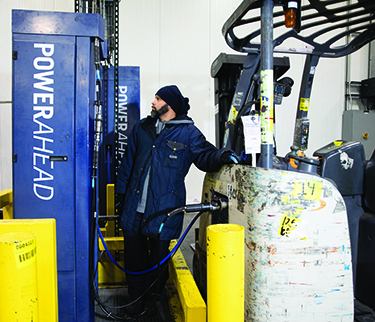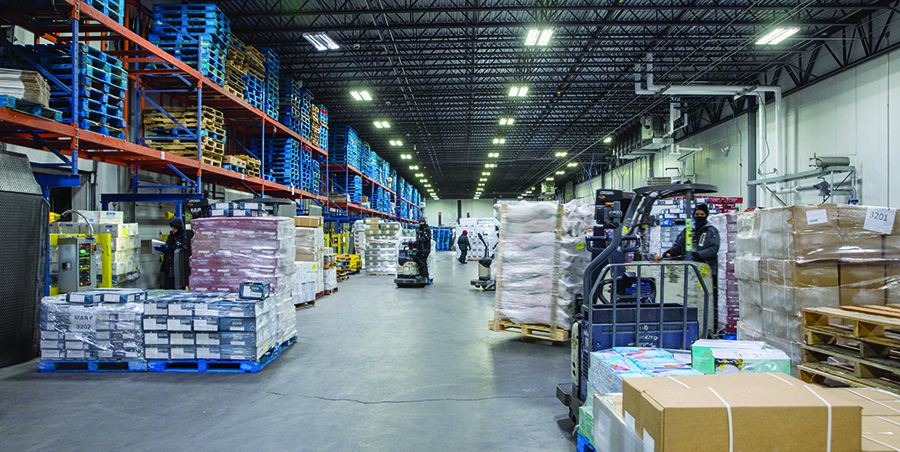It’s not easy to operate in a refrigerated or freezer warehouse. Bone-chilling temperatures take a toll on associates and equipmen...
It’s not easy to operate in a refrigerated or freezer warehouse. Bone-chilling temperatures take a toll on associates and equipment alike. Lift truck batteries are a great example. The cold reduces the amount of operating time you get out of a battery, which means additional spare batteries or more frequent charges. And, according to Dave Saoud, co-CEO and co-owner of FreezPak Logistics, along with his brother Mike Saoud, the cold also impacts battery life. “In a freezer, you drain the battery quickly, and it begins to degrade almost as soon as you put it into use,” Saoud says. “You’re losing productivity from day one.”
Lost productivity is just one of the reasons the Saouds switched to hydrogen fuel cells (Plug Power) as the energy source for their fleet of about 85 lift trucks (Crown), including very narrow aisle (VNA) trucks. The trucks are used in the three facilities FreezPak operates in Carteret, Paterson and Clifton, N.J.
The result of the switch, according to Mike Saoud, has been a 100% improvement in productivity in addition to freeing up valuable floor space that had once been devoted to battery rooms. Depending on the facility, that meant as much as an extra 5,000 square feet that could be used for refrigerated or dry storage.
More importantly, FreezPak has demonstrated that hydrogen fuel cell technology isn’t just for big companies operating spaces of 500,000 square feet or more. FreezPak’s experience, and learning curve, are an example for other companies interested in making the switch in their warehouses and distribution centers.
Service, service, service
While FreezPak Logistics has been in business for about 20 years, Dave and Mike Saoud grew up in contract logistics. Both began working forSaoud Enterprises, the food distribution business founded by their father some 50 years ago, when they were youngsters. They got the idea for FreezPak Logistics from their father while they were in college.
“The food distribution industry was changing and our father suggested starting a frozen storage business,” Mike recalls.
They launched the company before college graduation, leasing out 10,000 square feet in one of their father’s facilities. The business took off. In short order, they outgrew that space and bought their first building in Paterson, N.J. “We filled that one up, too, and from then on the business has been evolving and growing,” Mike says.
Today, FreezPak Logistics is a leading full-service cold and dry storage company, operating 10 million cubic feet across three facilities, include a state-of-the-art, 150,000-square-foot building with 52-foot ceilings they opened in 2015 in Carteret, near the largest port on the Eastern seaboard.
Working with Fuel Cells
![]()
The process at the FreezPak facilities is relatively straight forward. Newly arrived trucks check in with the guard shack and are directed to a dock. A text message is sent to a receiver’s tablet, telling them what door to go to. Depending on how the trailer is loaded, the receiver will use a fork truck or a pallet jack.
The receiver notifies the office once the unloading is complete. At that point, the warehouse management system (WMS) sends a message to the turret truck operators that product is available for putaway. Pallets are staged at pickup and delivery stations for the very narrow aisle (VNA) trucks, which are system directed.
When a truck needs to be refueled, it goes to a fueling station, much like going to a gas station pump. A communication module informs the driver whether the truck is ready to be refueled.
The driver connects a line to pump hydrogen into the fuel cell. In two minutes, it’s fully charged. Any gas left in the system is pushed back into the pad outside so that no gas is stored inside the building.
A 250,000-square-foot space in Clifton, N.J., handles ambient, refrigerated and freezer space. Starting with the first building, they have acted as their own general contractors, learning the ins and outs of building and operating freezer and refrigerated space.
![]()
They attribute their success to “service, service, service,” says Dave, a lesson they learned from their father. “We are hands on, and we are the face of the business,” he says. A significant percentage of the business is building mixed SKU pallets for custom distribution needs. “We can provide one-stop shopping from picking up product at the port, storing it, building pallets and delivering to your customer,” Mike adds. “And, now that we can do dry storage, we can build in-store promotional pallets, too.”
They also developed a broad line of business, including retail and wholesale clients along with expertise handling meat, seafood and vegetables.
The facilities, like the business, have evolved over time. The earliest facility had conventional ceiling heights. The first building they purchased in Paterson was a little taller, with 40-foot ceilings and overhead cranes that they removed. When they built the Carteret facility, they went to 52-foot ceilings, using very narrow aisle lift trucks for putaway and retrieval in that area.
Following the industry trend toward taller buildings and automation, they will break ground in the fall of 2020 to build a high-bay facility with 75-foot ceilings with an automated storage and retrieval system (AS/RS). The high ceilings and AS/RS technologies allow cold storage operators to get the cubic feet they need in a smaller real estate footprint.
While automation is more costly up front, the buildings are more efficient and cost-effective to cool and require less labor to operate. “With the new building, we’ll be 100% automated,” Mike says. The new Elizabeth, N.J., facility will house 30,000 freezer pallet positions and will be completed fourth quarter of 2021.
Batteries to fuel cells
As the buildings evolved, keeping up with battery charging in a harsh environment became a reality.
“Once we went to a 40-foot ceiling height in Paterson, lift trucks began limiting us,” says Mike. “We were doing a lot of opportunity charging and battery changing. And, that meant we had a lot of downtime where people weren’t working because a lift truck wasn’t available.”
In addition, 5,000 square feet of the Paterson facility was devoted to battery storage and charging. When the brothers began planning the Carteret facility, they wanted higher ceilings and very narrow aisle storage. With that came semi-automated turret trucks that communicate with the warehouse management system (WMS). The system determines the most efficient path to the next task, positioning the truck within inches of a storage or retrieval location.
![]()
Digital readouts alert lift truck operators to when cells need to be recharged and when they are full at the recharging station.
“That saves about 45 seconds for every pick,” Mike notes. “That’s important when you multiply that by the number of movements a fleet of trucks makes in a day. In addition, the turret trucks have heated cabs for operator comfort, but those are also a draw on batteries. But, the turret trucks also came with more power requirements. “A turret truck has two batteries,” says Mike. “We felt we were going to need two full-time people just to change batteries.”
In 2014, before construction was completed on the new building, the Saouds visited a facility that switched to hydrogen fuel cells. “We were blown away,” says Mike. “Instead of downtime for opportunity charging or battery changeouts, you could do a pre-check and fuel the truck in about 2 minutes. And, we realized that we could scrap the 5,000-square-foot battery rooms.”
The fuel cell provider was initially skeptical because it hadn’t previously worked with a smaller company, but the project moved forward. Today, Mike notes, “we have gotten totally away from batteries. The turret trucks, lift trucks and pallet jacks are all powered by fuel cells.”
There was, however, a learning curve.
Hydrogen powered
Converting to hydrogen is a process, Mike and Dave Saoud say. The first step was administrative, working with their landlord, local government and the fire department to get approval to build a plant on premises.
There, they convert condensed, liquid hydrogen delivered by high pressure tube trucks into a gas that is stored in buffer tubes. “We were going to be too big a user to have hydrogen gas delivered to us,” Mike says. The fire department, he adds, was used to dealing with flammable liquids at the port.
Today, FreezPak makes all of the hydrogen gas it needs at the Carteret facility, and ships the gas in their own tube trailer to its other two facilities, where it’s stored outside until needed.
![]()
The New Jersey-based family-owned business is using fuel cells across all of its existing facilities.
Two operational learnings: Lift truck drivers had to learn how far they could let the fuel cells run down before refueling. And, trucks parked on the refrigerated dock on Saturdays and Sundays, when the facilities aren’t operating, sometimes wouldn’t start up. “They would get too cold sitting idle over the weekend,” says Dave. “We had to fix the software so that didn’t happen.”
Last, but not least, there’s a significant upfront cost in comparison to battery-operated trucks. “But the savings in labor, real estate and productivity make up for that,” says Mike. As an example, the performance of a battery-powered lift truck degraded as the battery was depleted in low temperatures.
Meanwhile, “the fuel cell gives constant power, and we get more hours of operation from a full cell than from a fully charged battery,” Dave adds. The life of the fuel cells is about seven years, and they can be repaired on site if they break by a dedicated on-site technician.
With more than five years of experience under their belts, the Saouds say they will not go back to batteries. “We’re all about speed,” Dave says. “Drivers no longer have to wait for us to recharge a lift truck to load or unload their trailers. It’s improved our productivity 100%.”
And, they are now looking for opportunities to expand their use of fuel cells. “Plug Power asked us to do a pilot with our yard tractors, and we’re looking into that,” says Mike says. “We’re also looking at replacing the gas generator on their trucks that pickup containers coming off of ships with fuel cells.”
After all, he says, “Fuel cells are the future.”










 粤公网安备 44010602003952号
粤公网安备 44010602003952号